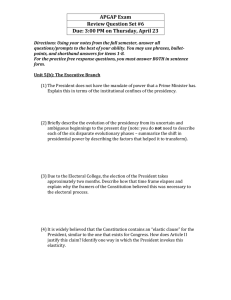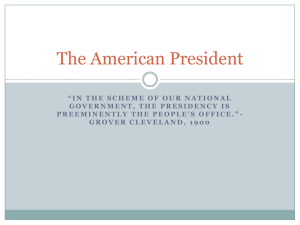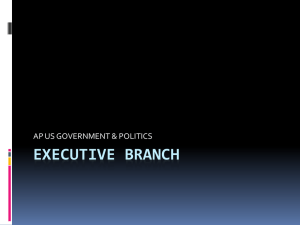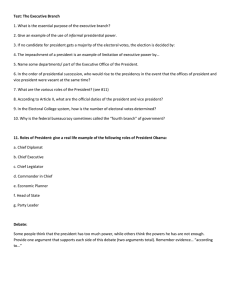AP Government
advertisement
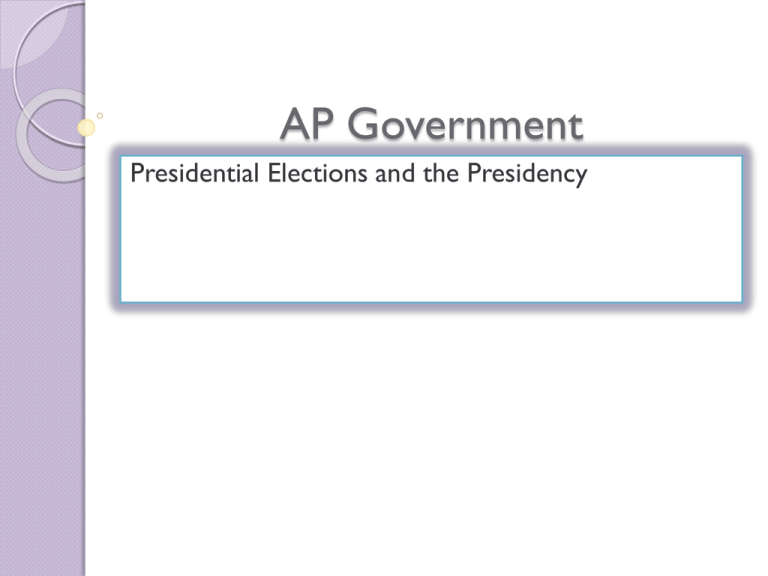
AP Government Presidential Elections and the Presidency The Road To The Presidency The Presidential Primaries ◦ In the early 1800s, congressional leaders held a caucus to select presidential candidates. ◦ Supporters of Andrew Jackson criticized the caucus system for being elitist. During the 1830s, the Jackson Democrats and the Whigs held party conventions to nominate their presidential candidates. ◦ Party bosses soon dominated the conventions. During the early 1900s, Progressive reformers promoted primary elections as a way of giving voters a greater role in the nomination process. The Road To The Presidency The Presidential Primaries (cont.) ◦ In 2008, 40 states held presidential primaries. The first primary is traditionally held in New Hampshire. In a process called frontloading, ¾ of the primaries are now held between February and mid-March. ◦ Primaries can be closed or open: In a closed primary, voters are required to identify a party preference before the election and are not allowed to split their ticket. In an open primary, voters can decide on Election Day whether they want to participate in the Democratic or Republican contest. The Road To The Presidency The Presidential Primaries (cont.) ◦ In the past, most presidential primaries were winner-take-all elections in which the candidates with the most votes won all the delegates. The Democratic Party has now replaced winner-takeall primaries with a proportional system that awards delegates based on the percentage of votes a candidate receives. The Republican Party currently uses both winner-take-all and proportional representation elections. ◦ Some states use a complex system of local caucuses and district conventions to select delegates. Iowa holds the best known and most influential caucus. The Road To The Presidency The Presidential Primaries (cont.) ◦ Critics argue that candidates devote too much time to Iowa and New Hampshire. Although both states are relatively small, they play a crucial role in generating media attention. ◦ Only about 25% of adult citizens cast ballots in primary elections. Primary voters tend to be party activists who are older and more affluent than voters in the general election. The Road To The Presidency The Party Conventions ◦ In the past, party conventions selected their presidential and vice presidential candidates after days of tense and often dramatic bargaining. As a result of victories in the primaries and caucuses, the leading contender now almost always has the nomination locked up before the convention begins. ◦ The conventions now serve three major functions: They formally name the party’s presidential and vice presidential candidates. They adopt a party platform They attempt to unify the party and generate positive publicity and momentum. The Road To The Presidency Campaign Spending and Reform ◦ Campaign costs have skyrocketed in 1988, George Bush and Michael Dukakis spent a combined total of $60.3 million to fund their activities during the primary season. In 2008, Barak Obama and John McCain spent $408 million to fund their primary campaigns. ◦ The Federal Election Reform Act of 1974 Created a Federal Election Commission to administer and enforce campaign finance laws. Provided partial public funding for presidential primaries. Provided full public financing for major party candidates in the general election. Placed limitations on individual contributions to presidential candidates. The Road To The Presidency Campaign Spending and Reform (cont.) ◦ Buckley v.Valeo (1976) The Supreme Court struck down the portion of the Federal Election Reform Act that limited the amount of money an individual could contribute to his or her own campaign. The Court ruled that contributing to one’s own campaign is a form of protected free speech: “The candidate, no less than any other person, has a First Amendment right to engage in the discussion of public issues and vigorously and tirelessly to advocate his own election.” The Road To The Presidency Campaign Spending and Reform (cont.) ◦ Soft Money Soft money includes unregulated donations to political parties for party-building expenses such as grassroots activities and generic party advertising. Reform laws failed to regulate soft money donations. Soft money was often used to circumvent limitations on hard money contributions. The Road To The Presidency Campaign Spending and Reform (cont.) ◦ The Bipartisan Campaign Reform Act of 2002 Reformers led by Senators John McCain and Russell Feingold aimed to eliminate soft money contributions. The Bipartisan Campaign Reform Act of 2002 banned soft money contributions. ◦ 527 Groups A 527 group is a tax-exempt organization created to influence the political process. 527 groups are not regulated by the Federal Election Commission because they do not coordinate their activities with a candidate or party. In 2004, 527 groups spent over $420 million on political messages. The Road To The Presidency The Electoral College ◦ Introduction The Framers created the Electoral College to safeguard the presidency from direct popular election. Each state has as many electoral votes as its combined total of representatives and senators. In the 2008 presidential election, seven states and the District of Columbia had three electoral votes, while California had 55 electoral votes. Texas has 34 electoral votes. Electors were originally chosen by their state legislatures. Today, they are selected by the parties. Although the Framers expected electors to be independent, they are now expected to vote for their party’s candidates for president and vice president. The Road To The Presidency The Electoral College (cont.) ◦ Consequences of the winner-take-all electoral college. The electoral college is a winner-take-all system. The presidential candidate who receives the most votes wins all of a state’s electoral votes. Candidates devote a disproportionate amount of time and resources to closely contested states, swing states, and competitive states. Candidates emphasize issues that may swing a key bloc of voters in a pivotal state. For example, candidates appeal to Florida’s large bloc of Cuban American voters by stressing their opposition to Fidel Castro. The winner-take-all system severely restricts the prospects of third-party candidates. The Road To The Presidency The Electoral College (cont.) ◦ Reasons why the electoral college has not been abolished. It would require a constitutional amendment to abolish the electoral college. The electoral college collectively benefits the small states that are guaranteed at least 3 electoral votes. The electoral college benefits racial minorities and interest groups located in key states. There is no consensus on how to reform the electoral college. The President As Chief Executive Executive Power ◦ The Constitution declares that “the executive Power shall be vested in a President of the United States of America.” ◦ As the nation’s chief executive, the president enforces the provisions of federal laws and administers a vast federal bureaucracy that spends more than $3 trillion a year and includes 2.7 million civilian employees. The President As Chief Executive Appointment Power ◦ The president has the power to appoint all of the following top-ranking officers of the federal government: Cabinet members and their top aides. The heads of independent agencies. Ambassadors and other diplomats. All federal judges, U.S. marshals, and attorneys. ◦ These appointments are all subject to confirmation by a majority of the Senate. ◦ The president’s appointment power is limited by an unwritten rule known as senatorial courtesy. According to this custom, the Senate will not approve a presidential appointment opposed by a majority party senator from the state in which the appointee would serve. The President As Chief Executive Removal Power ◦ Presidents have the power to dismiss most of the officials he or she appoints. ◦ It is important to note that the president cannot dismiss federal judges or commissioners of independent regulatory agencies. The President As Chief Executive The Cabinet ◦ The cabinet currently includes 14 executive department heads and the attorney general. These 15 executive departments employ nearly 2/3 of the federal government’s civilian employees. ◦ Cabinet members often have divided loyalties. Their loyalty to the president can be undermined by loyalty to the institutional goals of their own department. The President As Chief Executive The Cabinet (cont.) ◦ The following factors explain why presidents often experience difficulty in controlling cabinet departments: Interest groups often form close ties with cabinet departments. The careers of many civil servants extend beyond a single presidential administration. As a result, they develop a strong loyalty to their department. Congress competes with the president for influence over cabinet departments. The President As Chief Executive The Executive Office of the President ◦ The Office of Management and Budget (OMB) The OMB is the largest office within the Executive Office of the President. It includes a staff of over 500 career officials. The OMB’s primary responsibility is to assist the president in overseeing the preparation of the federal budget. The President As Chief Executive The Executive Office of the President (cont.) ◦ The National Security Council (NSC) The NSC is composed of the president’s principal foreign and military advisers. It includes the vice president, secretary of state, secretary of the treasury, secretary of defense, national security advisor, and others as necessary. The NSC’s principal function is to advise and assist the president on national security and foreign policies. The President As Chief Executive The Executive Office of the President (cont.) ◦ The Council of Economic Advisors (CEA) The CEA is a group of three leading economists who advise the president on economic policy. The CEA prepares the annual Economic Report of the President. The President As Chief Executive The White House Staff ◦ The White House staff includes key presidential aides such as the chief of staff and the press secretary. ◦ The chief of staff is the highest-ranking member of the Executive Office of the President, The chief of staff’s duties include selecting and supervising key White House staff and managing the flow of people and information into the Oval Office. The President As Chief Executive The White House Staff (cont.) ◦ The White House staff must be personally loyal to the president. ◦ The president can appoint and dismiss members of the White House staff without Senate approval. ◦ The White House staff’s primary responsibility is to provide the president with policy options and analysis. The President As Chief Legislator Legislative Powers ◦ The Constitution does not actually call the president the chief legislator. ◦ The Constitution does give the president the following powers: The president is required to give a State of the Union address to Congress. The president can bring issues to the attention of Congress “from time to time.” The president can veto congressional legislation. The President As Chief Legislator Legislative Powers (cont.) ◦ Presidents use their roles as national leader and head of the party to set the policy agenda. As a result, the president now initiates much of the major legislation that Congress considers. As noted by one prominent political scientist, “[N]o other single actor in the political system has quite the capability of the President to set agendas.” The President As Chief Legislator The Veto Power ◦ Presidential Options The president can sign a bill into law. The president can veto a bill, Congress may override the veto with a 2/3 vote in each chamber. The president can wait ten full days. If Congress is still in session, the bill will become law without the president’s signature. The president can exercise a pocket veto by waiting ten full days. If Congress adjourns before the ten days are up, the bill does not become law. The President As Chief Legislator The Veto Power (cont.) ◦ Using the Veto Congress is usually unable to override a presidential veto. Less than 10% of presidential vetoes have been overridden. Presidents often use the threat of a veto to persuade Congress to modify a bill. A vetoed bill is often revised and then passed in another form. Congress often inserts provisions the president wants into an objectionable bill in order to reduce the chances of a veto. The President As Chief Legislator The Veto Power (cont.) ◦ The Line-item Veto The president must accept or reject an entire bill. He or she cannot veto a portion of a bill. Many state governors have a line-item veto that allows them to veto specific items in a bill. In 1996, Congress passed a Line-Item Veto Act giving the president the power to strike individual items from major appropriations bills. Supporters hoped the line-item veto would enable the president to reduce wasteful government spending, pork, and earmarks. Just two years later, the Supreme Court struck down the lineitem veto as an unconstitutional expansion of the president’s veto power. A line-item veto can be enacted only by a constitutional amendment. The President As Chief Legislator Working With Congress ◦ Presidents prefer to establish a cooperative bipartisan relationship with Congress. ◦ Presidents use the following strategies to influence Congress to pass legislation: Assigning legislative liaisons from the Executive Office of the President to lobby legislators. Working with both the majority and minority leaders. Using the media to focus public attention on important issues. Using high presidential approval ratings to persuade legislators to support presidential programs. Bargaining with wavering legislators by offering concessions and pork that will benefit a member’s district. The President As Chief Legislator Divided Government ◦ Divided government occurs when the presidency and Congress are controlled by different parties. It also occurs when the chambers of Congress are controlled by different parties. ◦ Divided government has been a frequent result of elections over the past half century. ◦ The pattern of divided government has had a number of important consequences: It has heightened partisanship and made it more difficult for moderates to negotiate compromises. It has slowed the legislative process and thus created gridlock. It has contributed to the decline of public trust in government The President As Chief Legislator Divided Government (cont.) ◦ Divided government poses particular problems for the president in making federal appointments. It fosters stricter committee scrutiny, narrows the field of potential candidates, and sometimes sparks character attacks on nominees. ◦ Presidents attempt to overcome the problem of divided government by using the following strategies: Using the media to generate public support. Threatening to veto objectionable legislation. Making deals with key congressional leaders. Building coalitions with key interest groups. Increasing reliance on the White House Staff. The President As Chief Legislator TEST TIP ◦ Divided government has been a persistent fact of political life for the past half century. A number of free-response questions have asked to explain the impact of divided government on public policy, legislative gridlock, and federal appointments. The President and National Security Formal Constitutional Powers ◦ The president is the commander-in-chief and thus has the power to deploy troops. ◦ The president appoints all ambassadors subject to Senate confirmation. ◦ The president negotiates treaties, which are then subject to Senate ratification. ◦ The president has the sole power to recognize nations. ◦ The president receives ambassadors and other public ministers. The President and National Security Informal Powers ◦ The president can negotiate executive agreements with the heads of foreign governments. ◦ The president is a recognized global leader who meets with world leaders to build international coalitions. ◦ The president is expected to manage international crises. ◦ The president has access to confidential information that is not available to Congress or the public. The President and National Security The President As Chief Diplomat ◦ The president’s role as chief diplomat is derived from delegated powers stated in the Constitution. Congress normally defers to the president in foreign affairs. ◦ The president can both extend diplomatic relations to foreign governments and also terminate relations with other nations. For example, President Carter recognized the People’s Republic of China and severed relations with Iran. The President and National Security The President As Chief Diplomat (cont.) ◦ The president has the sole power to negotiate treaties with other nations. For example, President Wilson negotiated the Treaty of Versailles, which ended World War I, and President Carter negotiated the Panama Canal Treaty, which returned the Panama Canal to Panama. The Constitution gives the Senate the power to approve or reject treaties by a 2/3 vote. The Senate rejected the Treaty of Versailles and approved the Panama Canal Treaty. The President and National Security The President As Chief Diplomat (cont.) ◦ Presidents rely more and more on executive agreements rather than formal treaties. An executive agreement is a pact between the president and a head of a foreign state. Executive agreements do not have to be approved by the Senate. Unlike treaties, executive agreements are not part of American law and are not binding on future presidents. Notable examples of executive agreements include the destroyers-for-bases deal with Great Britain, the Viet Nam peace agreement, and the SALT I agreement limiting offensive nuclear weapons. The President and National Security The President As Commander-in-Chief ◦ The Constitution specifically makes the president the commander-in-chief of America’s armed forces. ◦ The Constitution specifically grants Congress the power to declare war. Nonetheless, since World War II, modern presidents have frequently sent U.S. forces into combat without a formal declaration of war. Examples include the Korean War, the Viet Nam War, the Persian gulf War, and the Iraq War. The President and National Security The President As Commander-in-Chief (cont.) ◦ The president’s commitment of troops into battle has generated great controversy between the executive and legislative branches. ◦ In 1973, Congress passed the War Powers Resolution to ensure congressional involvement in decisions committing military forces to hostile situations overseas. The War Powers Resolution includes the following key provisions: The president must notify Congress within 48 hours of deploying troops. The president must bring troops home from hostilities within 60 to 90 days unless Congress extends the time. The President’s Judicial Powers Granting Reprieves and Pardons ◦ The Constitution gives the president the power to grant reprieves and pardons. ◦ A reprieve is the postponement of the execution of a sentence. ◦ A pardon is the legal forgiveness of a crime. For example in 1974, President Ford pardoned former president Nixon for crimes he committed during the Watergate scandal. The President’s Judicial Powers Appointing Supreme Court Justices ◦ The president has the power to appoint justices to the Supreme Court. Presidential nominees must be confirmed by the Senate. ◦ Presidents use this power to select justices with judicial philosophies that are compatible with their interpretation of constitutional questions. The President And The Media The Importance of Public Support ◦ Public support is critical to presidential success. ◦ One top aide to President Reagan underscored the importance of public support when he said, “Everything here is built on the idea that the President’s success depends on grassroots support.” The President And The Media Presidential Approval Levels ◦ For over 50 years, the Gallup Poll has asked Americans, “Do you approve or disapprove of the way [name of the President] is handling his job as president.” ◦ Data from the Gallup Poll and other public opinion surveys show that the following factors increase presidential approval ratings: Brief “honeymoon” periods at the beginning of an administration. Positive media coverage of presidential activities and decisions. Foreign policy success. Foreign crisis that produce a “rally round the flag” effect. Strong economic growth and low unemployment. The President And The Media Presidential Approval Levels (cont.) ◦ Data from the Gallup Poll and other public opinion surveys show that the following factors decrease presidential approval ratings: Scandals involving the president and/or top aides. A gap between high expectations and poor job performance. Foreign wars that go badly over a protracted period of time. The President And The Media The President and the Media ◦ The media plays a key role in influencing how the public perceives a president. ◦ The president is generally more successful than congressional leaders in using the media to set the policy agenda. ◦ The following factors give the president an advantage over Congress in gaining media attention: The president represents the entire nation. In contrast, members of Congress represent districts and/or states. The president is the leader of the “free world.” The president is more powerful than any individual member of Congress. The president speaks with a single voice. In contrast, Congress has 535 competing members. The President And The Media TEST TIP ◦ Most AP Government and Politics exams contain a multiple-choice question asking you to identify which answer choice is not a presidential role or formal power. It is important to remember that the Constitution does not allow the president to form new cabinet-level departments, raise revenue, or declare war. While the president is the leader of his or her political party, this role is not authorized by the Constitution.

